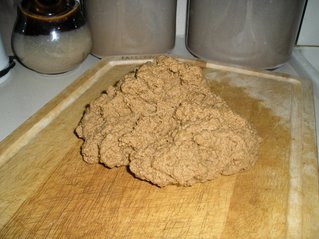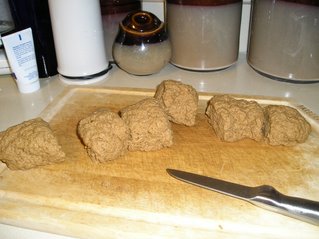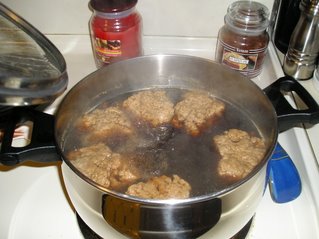 Breafast, lunch and dinner!
Breafast, lunch and dinner!After my first race of the season (an 8K in about 36 minutes, not bad!- placed first in my "ancient" age group!), I decided I needed something a little heartier than my usual grapefruit and muffin. So I treated myself to this Power Porridge with Coconut Pecan Marmalade, from The Candle Cafe Cookbook, I was really excited! I wasn't disappointed, either. The porridge cooked up nice and thick, and the flavor was awesome. I have been re-heating it for breakfast all week, as we say goodbye to winter! The "marmalade" was nothing like real marmalade and a bit too sweet, but my sweet tooth was happy! I also added some dried cherries that were just perfect. The porridge is made from steel cut oats and quinoa, the power grain of them all. As you will learn more below, quinoa is also an excellent protein, as well as contains more calcium than milk! Scroll to the bottom of this post to learn more!

Black Bean-Quinoa Salad with Basil-Lemon Dressing, for lunch
from Cooking Light Magazine, March 2006 issue
 And Quinoa Curry with Mango Chutney for dinner (the latter was storebought - Major Grey brand, the former from Vegetarian Times, February 2007 issue).
And Quinoa Curry with Mango Chutney for dinner (the latter was storebought - Major Grey brand, the former from Vegetarian Times, February 2007 issue).A little about, "QUINOA"
Pronunciation: "KEEN-wa"
What is it? (How it's made): Well, it's a grain, so... you grow it! It is very tiny and light, and looks like little circles. Comes in different colors, from red to black to yellow (whitish) and more.
History: Where were you 5,000 years ago? Well, if you were an Incan, you would have eaten quinoa! Grown in the Andes region and feeding many different local people, it was known as the "mother grain." It was even used in sacred rituals and planted with a golden spade or shovel by the king at the beginning of the planting season (Seeds of Change, www.seedsofchange.com). As conquerors came to the area and introduced other grains such as wheat, it became associated with those whom they conquered, and thus an inferior food. It is just in recent years (since the 70s) that quinoa has started to win back followers (Jordan Erdos, planeta.com).
Health benefits: A complete protein- all by itself! It was the primary meat-alternative protein source for the Incans. Not only an incredible protein source (has more protein than any other grain), one cup has more calcium than a cup of milk (Isa Moskowitz, Vegan with a Vengeance, 2005) and three times as much calcium as wheat (Jordan Erdos, planeta.com, Dec. 1999). It is also gluten-free, for those with allergies. Also high in omega-3 fatty acids and iron.
Myths and tips: It sounds funny- it can't be any good... WRONG! This delicious and light grain cooks up in less time than most rices. It is filling and versatile. A nutty flavor and slight crunch.
Tip: Rinse the grain well in a fine sieve to remove the bitterness.
Tip: Quinoa is done (being cooked) when there is a white ring around the edges of the grain pieces.
Common uses: Typically eaten as a side dish, like rice, or used in main dish cold salads. However, it can be used like rice and other grains in recipes such as stuffed peppers, too!
Black Bean, Mushroom and Quinoa-Stuffed Peppers, from Vegan with a Vengeance, by Isa Moskowitz














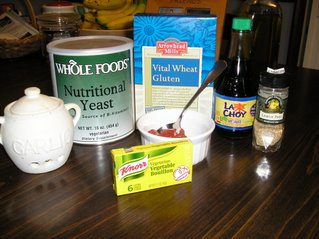

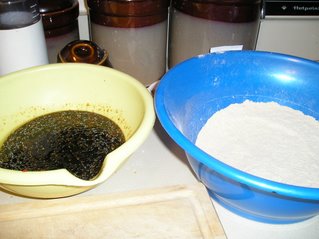

 Step 4) Knead the mixture for five minutes. If you have ever made fresh bread (if you haven't, you just have to try it !), this is the fun part. It's sometimes hard to make it stay together. Kneading is pressing with the heels of both hands and pushing it away from you. You do this once, then turn it a quarter clockwise, fold the top back and knead again. If it doesn't feel "spongy" after five minutes, do it for a couple minutes more.
Step 4) Knead the mixture for five minutes. If you have ever made fresh bread (if you haven't, you just have to try it !), this is the fun part. It's sometimes hard to make it stay together. Kneading is pressing with the heels of both hands and pushing it away from you. You do this once, then turn it a quarter clockwise, fold the top back and knead again. If it doesn't feel "spongy" after five minutes, do it for a couple minutes more.